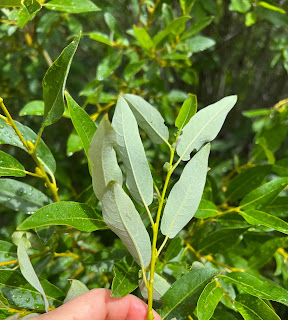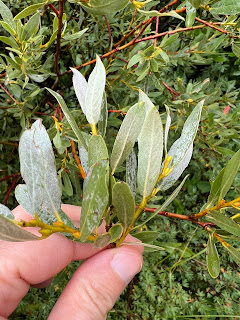Posted by Mollie Freilicher, CSU Extension, Tri-River Area
Even though it meant a trip through Glenwood Canyon twice on a rainy day, last week I attended a willow identification workshop in and around Vail. (Spoiler alert - the canyon stayed open and the workshop was great!)
The workshop was hosted by the Betty Ford Alpine Gardens and the Colorado Native Plant Society and led by botanist Gwen Kittel. Gwen recently published a book on willow identification Willows (Salix) of Colorado: Their Ecology & Identification. Willows (genus Salix) readily hybridize, which can make identification difficult. I was hoping to demystify willow identification a bit and learn more about the species of willow here in Colorado, and particularly on the Western Slope. Other attendees included CSU Extension Native Plant Master Trainers, consultants, and others interested in learning more about native willows.
 |
| Mountain willow (Salix monticola), upper side of leaves |
 |
| Mountain willow (Salix monticola), lower side of leaves |
We dove right in at the bike path at Copper Mountain, elevation 9,830 ft. Gwen handed us a vegetative key she developed for willows (and recently revised for her book). She walked us over to our first prospect and asked us to key it out. After what felt like an eternity and lots of looks at leaf hairs under a hand lens, we arrived at the species, Drummond’s willow (Salix drummondiana)…and then proceeded to do six more at the site.
 |
| Willows along the bike path at Copper Mountain. |
Some of the things we were looking for as we went through the key -
We moved on to the second site at Vail Pass, elevation 10,663. Here we had a great comparison of two willows, we had seen at the first site - planeleaf willow (Salix planifolia) and Wolf’s willow (S. wolfii var. wolfii). We could easily see the hairy leaf underside of Wolf’s willow, compared to the smooth hairless, planeleaf willow.
- Were the twigs pruinose? That is, did they have a waxy coating on the twig surface?
- How hairy are the leaves? Are they hairy above? Below?
- How much longer are the leaves than wide?
- And much more
 |
| It took a close look to distinguish Wolf's willow and planeleaf willow. |
 |
| Looking closely, we could see the hairs on the upper and lower leaf surface of Wolf's willow. |
We had, for the most part, dodged the rain, but by the time we got to the last stop, the Betty Ford Alpine Gardens in Vail, elevation 8,200, it was pouring and was not going to stop.
 |
| One of the last willows we identified, coyote willow (Salix exigua). Unlike all the other willows we had seen during the day, this one had much narrower leaves. |

No comments:
Post a Comment